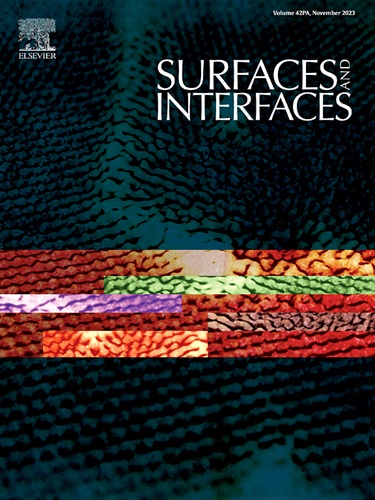Removal of F- from industrial ZnSO4 solution by hierarchical porous Al2O3-ZnO microspheres: performance and mechanism
IF 5.7
2区 材料科学
Q2 CHEMISTRY, PHYSICAL
引用次数: 0
Abstract
As mineral resources are developed and exploited, the proportion of low-grade zinc ore increases. The concentrations of F- exceeding the optimal range may pose a risk to zinc hydrometallurgy. In the present research, Al2O3-ZnO microspheres (AZO) characterized by a substantial specific surface area were synthesized through a hydrothermal-roasting technique and applied in industrial zinc sulphate fluoride removal. The optimal adsorption conditions for AZO and the underlying adsorption mechanism were investigated. The results indicated that the adsorption at 12 g·L-1 dosage, original pH=5.32 of the solution and 323 K for 75 min, when the fluoride concentration was reduced to below 50 mg·L-1, the fluoride removal percentage reached 73.32 %, and the adsorption capacity was 8.55 mg·g-1. Kinetic studies revealed that AZO exhibited surface inhomogeneity, functioning as a heterogeneous adsorbent, with the fluoride adsorption process being predominantly chemical in nature. The isotherm model suggested that the removal process was characterized by homogeneous adsorption of a monomolecular layer, with a theoretical maximum adsorption capacity of AZO estimated at 9.479 mg·g-1. FT-IR and XPS analyses demonstrated that the defluorination process occurs through ion exchange between F- and -OH, as well as the formation of Zn/Al-F complexes. Consequently, AZO present a novel approach for developing an effective adsorbent for defluorination in industrial ZnSO4 solutions.

分级多孔Al2O3-ZnO微球去除工业硫酸锌溶液中的F-:性能和机理
随着矿产资源的开发利用,低品位锌矿占比不断增加。氟的浓度超过最佳范围可能对湿法炼锌造成危害。采用水热焙烧技术合成了具有较大比表面积的Al2O3-ZnO微球(AZO),并将其应用于工业硫酸锌的除氟。研究了AZO的最佳吸附条件和潜在的吸附机理。结果表明:在12 g·L-1投加量、初始pH=5.32、323 K条件下吸附75 min,当氟浓度降至50 mg·L-1以下时,除氟率达到73.32%,吸附量为8.55 mg·g-1。动力学研究表明,AZO表现出表面不均匀性,是一种非均相吸附剂,氟吸附过程主要是化学吸附。等温线模型表明,吸附过程为单分子层均匀吸附,AZO的理论最大吸附量为9.479 mg·g-1。FT-IR和XPS分析表明,除氟过程是通过F-和- oh之间的离子交换以及Zn/Al-F配合物的形成而发生的。因此,AZO为开发工业硫酸锌溶液中有效的除氟吸附剂提供了一种新的途径。
本文章由计算机程序翻译,如有差异,请以英文原文为准。
求助全文
约1分钟内获得全文
求助全文
来源期刊

Surfaces and Interfaces
Chemistry-General Chemistry
CiteScore
8.50
自引率
6.50%
发文量
753
审稿时长
35 days
期刊介绍:
The aim of the journal is to provide a respectful outlet for ''sound science'' papers in all research areas on surfaces and interfaces. We define sound science papers as papers that describe new and well-executed research, but that do not necessarily provide brand new insights or are merely a description of research results.
Surfaces and Interfaces publishes research papers in all fields of surface science which may not always find the right home on first submission to our Elsevier sister journals (Applied Surface, Surface and Coatings Technology, Thin Solid Films)
 求助内容:
求助内容: 应助结果提醒方式:
应助结果提醒方式:


